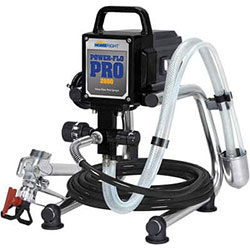Best House Paint Sprayer — Buyer’s Guide, How-To, Reviews, and Comparison
Why endure painful wrists and arms and witness unsatisfying results with a brush or roller, when a house paint sprayer can provide the ultimate blemish-free coat with the minimum of effort. These impressive units deliver more rapid coverage than manual methods, and their fine atomization ensures the smoothest of finishes. Available as both airless units and HVLP turbine machines, these sprayers are compatible with the house painting staples of latexes, chalks, and acrylics — with some monsters able to knock out elastomerics, block fillers, and roof coatings. Whether you’re addressing flooring, walls, or ceilings — or attacking a single room or the entire house interior and exterior — there’s a DIY or pro-grade tool for the job.
- Multi-medium compatible.
- Incorporated filters.
- Affordable airless machine for DIYers and contractors.
- Straightforward cleaning.
Best House Paint Sprayer Information
House Paint Sprayer Comparison Table
| IMAGE | PRODUCT | DETAILS | ||
|---|---|---|---|---|
|
Best Paint Sprayer for Outside of House 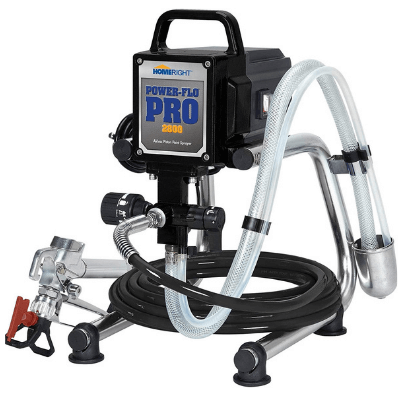
|
Best Paint Sprayer for Outside of House
|
Features
|
Check Price at Amazon HomeRight Power Flo Review HomeRight Power Flo Review | |
|
Best Paint Sprayer for House Interior and Exterior
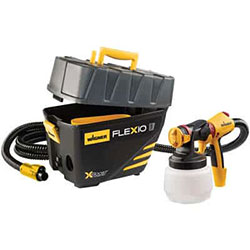
|
Best Paint Sprayer for House Interior and
Exterior
|
Features
|
Check Price at Amazon Wagner FLEXiO 5000 Review Wagner FLEXiO 5000 Review | |
|
Best Residential Paint Sprayer for Contractors 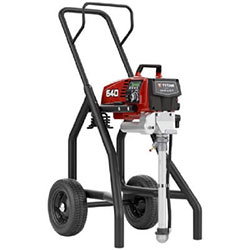
|
Best Residential Paint Sprayer for Contractors
|
Features
|
Check Price at Amazon Titan 640 Paint Sprayer Review Titan 640 Paint Sprayer Review | |
|
Best Home Paint Sprayer With Airless Pump 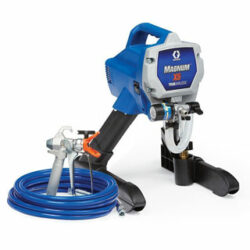
|
Best Home Paint Sprayer With Airless Pump
|
Features
|
Check Price at Amazon Graco Magnum X5 Review Graco Magnum X5 Review | |
|
Best Home Interior Paint Sprayer 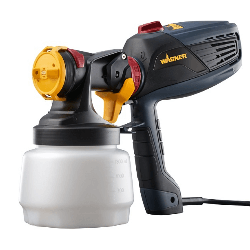
|
Best Home Interior Paint Sprayer
|
Features
|
Check Price at Amazon Wagner FLEXiO 2000 Review Wagner FLEXiO 2000 Review | |
|
Best Dual Nozzle Home Paint Gun 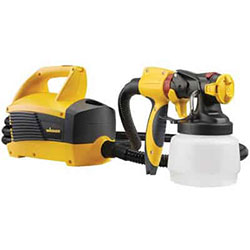
|
Best Dual Nozzle Home Paint Gun
|
Features
|
Check Price at Amazon Wagner FLEXiO 4000 Review Wagner FLEXiO 4000 Review | |
|
Best Home Paint Spray Gun With Low Overspray 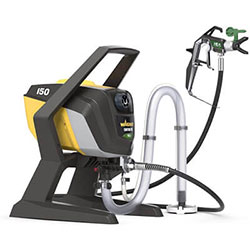
|
Best Home Paint Spray Gun With Low Overspray
|
Features
|
Check Price at Amazon Wagner Control Pro 150 Review Wagner Control Pro 150 Review | |
|
Best Household Paint Sprayer With a Turbine 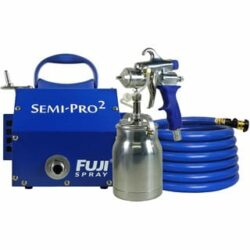
|
Best Household Paint Sprayer With a Turbine
|
Features
|
Check Price at Amazon Fuji 2202 Semi-PRO 2 Review Fuji 2202 Semi-PRO 2 Review | |
|
Best Homeowner Paint Sprayer on a Budget 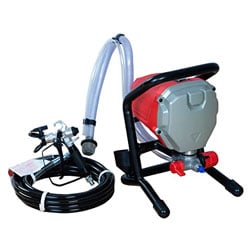
|
Best Homeowner Paint Sprayer on a Budget
|
Features
|
Check Price at Amazon Himalaya Airless Review Himalaya Airless Review | |
|
Best Gasoline Powered House Spray Painter 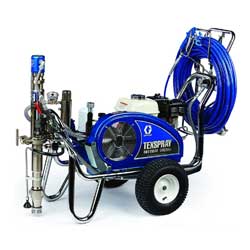
|
Best Gasoline Powered House Spray Painter
|
Features
|
Check Price at Amazon Graco GH230 Review Graco GH230 Review |
Best House Paint Sprayer Buying Guide
These versatile units take the hassle, headaches, and time-cost out of large area coverage while delivering a pleasing coat — whether you’re addressing internal or external walls. Available at a variety of price points and suitable for both thin and seriously dense mediums — there’s a power tool for every DIYer and trade-user.
Why Should You Use House Paint Sprayers?
Unless you’re Amish, an extreme painting traditionalist, or a glutton for punishment — times have moved on. You don’t send a pigeon to your buddy to invite him out for a beer — WhatsApp, Messenger, Snapchat, and Tik-Tok (ask your daughter) have made that avian method of communication totally obsolete. Social media messaging has destroyed flappity-flappity rat-with-wings-chat in the same way power-painters have negated brushes and rollers.
Ok, admittedly handheld tools can have their place in residential painting — they’re excellent for cutting-in door frames, ceilings, and baseboards (although you can purchase guide-tools for power painters for accurate edging too). And, if you’re covering a ridiculously small area — it might be quicker just to load-up a roller instead of hauling the spray machine out of the garage.
However, for medium to large-scale addressing of property walls and ceilings — you need a home spray paint gun.
The advantages of using a powered spray gun for house painting, instead of a manual tool, are:
- They’re power tools for men — brushes are only for girls, children, and Bob Ross.
- Five-times faster than a roller — check out my Roller Vs House Spray Gun face-off.
- Ten-times more rapid than a brush.
- You can’t use a roller on room corners — home paint sprayers can access these areas.
- House paint air spray guns deliver a consistently even mist — rollers and brushes are variable, depending on how vehemently you load them up.
- Power-painters can knock out the densest of mediums — like elasticized textured wall coatings — try doing that for more than five minutes with a brush.
- Painting a house with a sprayer requires less physical effort than a brush or roller — increasing stamina, enabling you to last longer, and preventing a premature finish.
- Wielding the best paint gun for house decoration is fun — show me someone who says the same about addressing a wall with a brush, and I’ll show you a liar or a masochist.
How to Choose the Best Paint Guns for Houses
Their versatility means that they’re not traditionally marketed online or in catalogs as a paint sprayer for home. If a unit is capable of delivering thin and dense paints on house walls — it’s going to be equally useful for attacking fencings, deckings, and outbuildings.
Hence, finding the ideal home machine — like taking the perfect selfie — is challenging and frustrating.
To make the process easier (selecting a household paint sprayer that is, not taking photos of yourself), I’ve made a shortlist of a few crucial considerations when selecting the best air paint sprayer for home use.

The Paint Gun House Machine Type
Three, that’s the magic number.
Yes, it is.
It’s the magic number.
What these Long-Island rappers were probably referring to was the trio of paint sprayers that are available in the market — airless, turbines, and compressor-driven (although some radical music-aficionados believe they were actually talking about the number of members in the band — not power tools).
Theoretically, house spray painting machine units can exist in all of these three formats — although airless and turbines are the most popular.
Turbine Paint Sprayer for House Painting
Turbines are the most straightforward to operate and affordable power tools out of the three categories — making them the best paint sprayers for home use for casual and intermittent DIYers.
Utilizing a fan, or series of fans (known by techie experts as ‘stages’) to drive the paint — they’re easy to maintain and are capable of delivering dense latex paints. Typically HVLP (high-volume low-pressure) units create a smoother coat than airless machines, but their speed of delivery is slower.
Perhaps the best paint gun for home use that uses a turbine is the mighty Wagner FLEXiO 5000 — a unit that’s rated for indoor and outdoor applications, is highly rated in online home paint sprayer reviews, and can handle latex, chalk, and milk paints.
Airless Paint Sprayer for Home Use
One of the main reasons you paint house with spray gun is because it offers more rapid coverage than a roller or brush. And, while turbine units deliver fast application — it’s the airless units that are the Formula 1 of the power-painting world.
Usually knocking out above 3000 PSI from a hydraulic pump — compared to the 5-10 PSI of turbines — these powerful machines are the choice of the trade-pro due to their ability to complete vast swathes of walling in a relatively short time — keeping costs to a minimum.
Additionally, their mighty power output allows them to deliver more viscous mediums than turbines — such as epoxies, block-wall fillers, and textured coatings. Thus meaning they’re the paint guns house exterior specialists.
The downside to these impressive units is that they’re heavy, high on overspray (unless you get a high-efficiency airless such as the Control Pro 150), and slightly more complicated to operate than HVLP turbines.
The units range from the DIY-focused Magnum X5, through to the behemoth contractor-grade gasoline-driven Graco GH230 — and our best airless paint sprayer for home use, the HomeRight 2800.
Compressor-Driven Paint Sprayer to Paint House
While it’s possible to paint house with sprayer driven by a compressor — it’s unusual, hence why no pneumatic guns appear in my top picks.
Don’t get me wrong, compressor sprayers are excellent power painters. With HVLP and LVLP guns providing the ultimate in atomization and hence the most perfect coat out of all the spray unit types — they’re the choice of cabinet restorers, crafters, and automotive resprayers.
However, to spray paint house interior and exteriors with one of these tools is serious overkill. A perfect showroom finish is fine for motor vehicles — but not required on walls, especially house externals. Even the traditional method of wall painting — using a roller — is renowned for its stippled, textured finish.
Additionally, as the name suggests, these guns run off compressors. These monster-like pneumatic powerhouses are the exact opposite of portability. Moving these units around your home involves a lot of effort — and the noise they emit means they’re not going to please the wife while she’s watching her favorite box set.
Handheld or External Power Unit
Both turbine and airless machines are available in handheld format — that is, the power unit is incorporated into the gun itself instead of sitting on the floor. This increases the portability of the sprayer and allows for significant operating freedom — as long as it includes a lengthy power cord.
However, these handheld examples are only suitable for small house painting projects — as many lack the power to knock out dense mediums and provide a relatively poor speed of coverage.
Furthermore, as the gun includes both the paint container and motor, it makes for a hefty shooter — increasing the risk of fatigue.
Conversely, external units offer greater power, higher atomization, and more speedy coverage — making them, in most cases, the best way to paint a room with a sprayer.

Paint Container
As I mentioned at the beginning of this house paint spray gun reviews article — addressing property internal and external walls will probably be the largest power-painting coverage project you will undertake.
And, a lot of wall area means a lot of paint.
Turbine units feature a gun-mounted container to store the coverage medium. Naturally, the larger this cup, the fewer times you’ll have to refill — saving you valuable downtime. At the very least, look for a unit that has a one-quart container, which will hold sufficient capacity for around 120 square feet of coverage. Less volume than this will mean frequent replenishment, which is a serious hassle if you’re addressing multi-rooms or a complete external repaint.
However, in my opinion, the best paint sprayer for home use in the volume category has to be an airless machine. These units have no gun-incorporated containers — instead, they draw directly from an original one or five-gallon paint can via a suction hose.
Not only does this mean there’s no requirement to replenish a cup — but it also reduces the weight of the gun itself — lowering the risk of arm and hand fatigue.
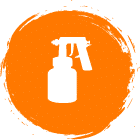
Hose Length
As Ron Jeremy will agree, length is everything.
The longer your spray hose, the fewer times you will have to relocate the base turbine or hydraulic pump — saving you both effort and time, and allowing you to operate in areas a fair distance away from a power outlet.
The best paint sprayer for home use will have a hose at least 10-feet long. This minimum length should allow you to complete an entire room respray with no relocation of the motor housing — as long as you can place the unit in the center of the room.
However, the longer the better.
Greater hose distance capacity means more operational freedom — especially crucial for house exteriors. A massive hose means you’re not having to lug your base unit up ladders to address high-level areas — not just hard work but a serious safety hazard.
The affordable Titan 640 boasts a 50-foot snake, while the hardcore contractor-grade Graco GH230 delivers an eye-watering 100-feet of hose.

Medium Compatibility
The best paint sprayer for homeowner and residential renovators will have both the nozzle and power output to knock out your chosen paint type.

Nozzle Tips
The nozzle is a crucial consideration when selecting an air paint sprayer for house painting — the component atomizing the paint and delivering it onto your base material.
Usually measured in millimeters, the diameter of this tip determines the thickness of the coating medium your unit will propel. As the house painting staples of latex, milk, and chalk-based liquids and external textured paint are typically viscous — you need a wide nozzle to ensure sufficient coverage.
In general terms, a turbine machine with a 1.6 mm air cap end will happily drive these dense paints — while the higher PSI of airless sprayers permits the use of a narrower tip at around 1.3 mm. For more info — check out my guide to sprayer tips.
Some units, such as the Wagner FLEXiO 5000, come with a choice of more than one tip — a wide diameter nozzle for dense paints and a narrower nozzle for finishing work.
How to Paint Your House With a Airless Sprayer on External Walls
What You Will Need to Follow This Tutorial
Painting the exterior of your house gives it a new lease of life, becomes the envy of the neighbors, and can deliver valuable curbside appeal if you’re thinking of selling. Before you dive into my external house painting 101 — here’s a list of everything you will need.
- Paint gun suitable for external painting — such as the Titan 640.
- Telescopic ladder.
- Pressure washer.
- Masking tape and drop cloths.
- Paint stirring sticks.
- Paint — duh.
- Mixing cups.
- Paint scraper.
- Suitable nozzle for the paint type.
- Paintbrush for edging.
- Cleaning brush and soapy water.
- Polythene sheeting.
- Overalls.
- Dust mask, safety goggles, and gloves.
- Extension cable and breaker, if operating away from power outlets.
How to Paint a House With a Spray Gun Outside — Step By Step Guide
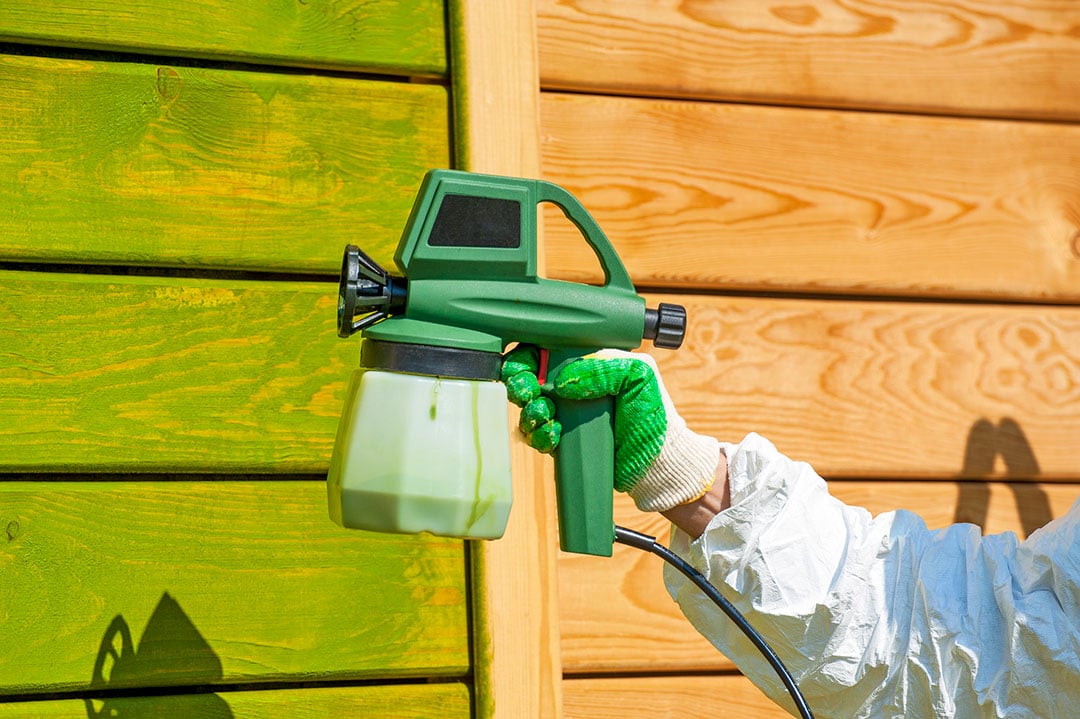
Step 1 — Preparation
- Before we get into the meat of how to paint a house with a sprayer — put on your protective equipment.
- Ensure the floor/garden/yard area surrounding the house walls is clear — this prevents tripping hazards, creates easier access, and ensures wayward paint doesn’t damage planters, cycles, grills, and outdoor furniture. If something is immovable — utilize a drop cloth.
- Use masking tape and poly-sheeting to shield doors, frames, windows, downpipes, etc., from paint splashes.
- Remove any old loose paint from the walls with a scraper or a stiff wire brush — this both allows for a cleaner final coat and ensures better adhesion for your covering medium.
- Wash the walls to remove any dust and debris — at the very least, utilize a brush with hot soapy water. However, a power-pressure washer is quicker, creates a better base, and requires less effort. Also, pay attention to remove any mold or lichen, which will show through your new coat. For access to high-level areas, you may need a ladder — ensure it’s placed on an even ground surface.
- Wait for the walls to dry. Exterior paint is typically water-based — hence applying to wet walls will lead to drips and dilution of your material. Depending on the time of year and your geographical location — drying could take hours or days.
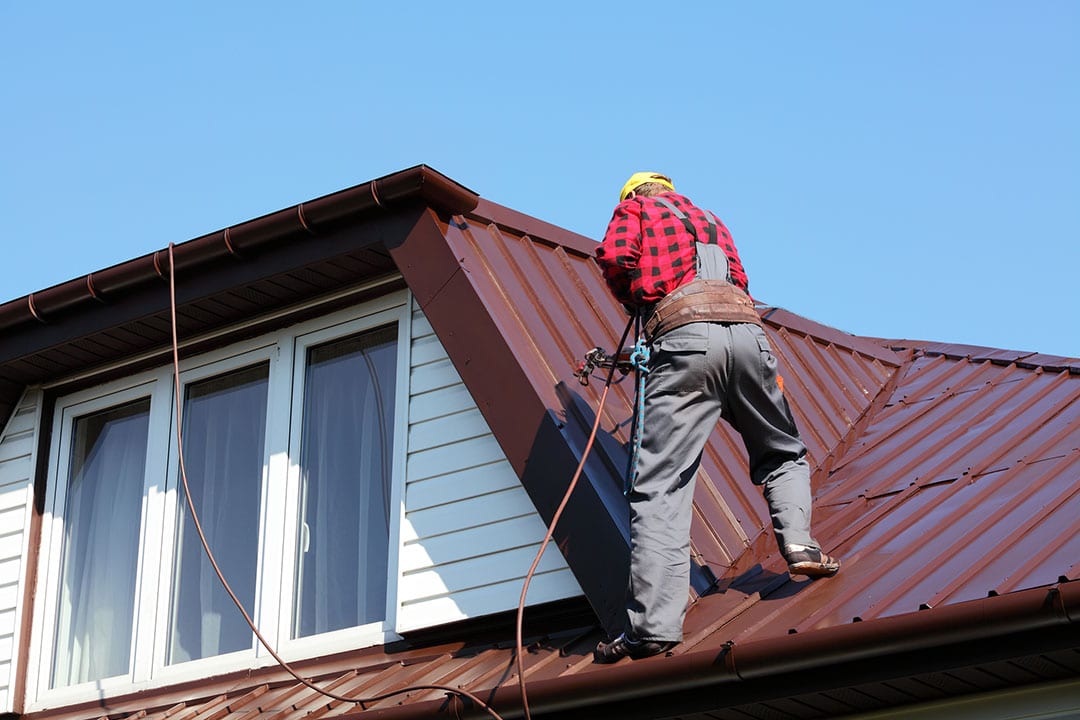
Step 2 — Painting the House Exterior
- Choose a day to paint when the weather is dry and there’s little wind — you don’t want to be perched upon a ladder in hurricane conditions.
- Don your safety equipment.
- Prepare your paint. If you need to thin your coating medium before application, dilute in a mixing cup with water or oil-based thinners — depending on your paint type. Combine thoroughly by using a paint stick. As a rule of thumb, you’ll need one gallon of paint for every 400 square feet.
- Ensure your paint sprayer has access to a power outlet — using a suitably rated extension cord and circuit breaker.
- Set-up your paint sprayer for action. Exact requirements depend on the make and model of your machine — but as a general guide, I’ve put together a 101 on preparing an airless or turbine sprayer.
- If needed to reach higher areas — set up your ladder. Always paint from the top of the house to the bottom. Ensure that your ladder is secure and locked before climbing. Additionally, check that your hose is sufficiently lengthy to allow easy maneuverability while on the ladder.
- Begin to spray, reach no more than arm’s length on either side of the ladder. Then, gradually descend and continue spraying until you reach the bottom — move the ladder 1-1.5 meters to the side, and start from the top of the house again.
- Spray from a distance of 8-12 inches — the build of your home will determine the application motion. If you have vertical boards, paint up-and-down, for horizontal slats, utilize a side-to-side action. Conversely, if your house is rendered, you can use side-to-side or circular motions.
- Wait for the paint to dry. In clear, daylight conditions, check whether the house needs an additional coat.
- Address any woodwork, trim, and fascias with a paintbrush or, if you have a suitable detail tip, your spray gun.
- Stand back, crack open a cold one, and check out your amazing work. Compare it to the sad state of your neighbor’s property.
How to Use a Spray Gun to Paint a House Interior
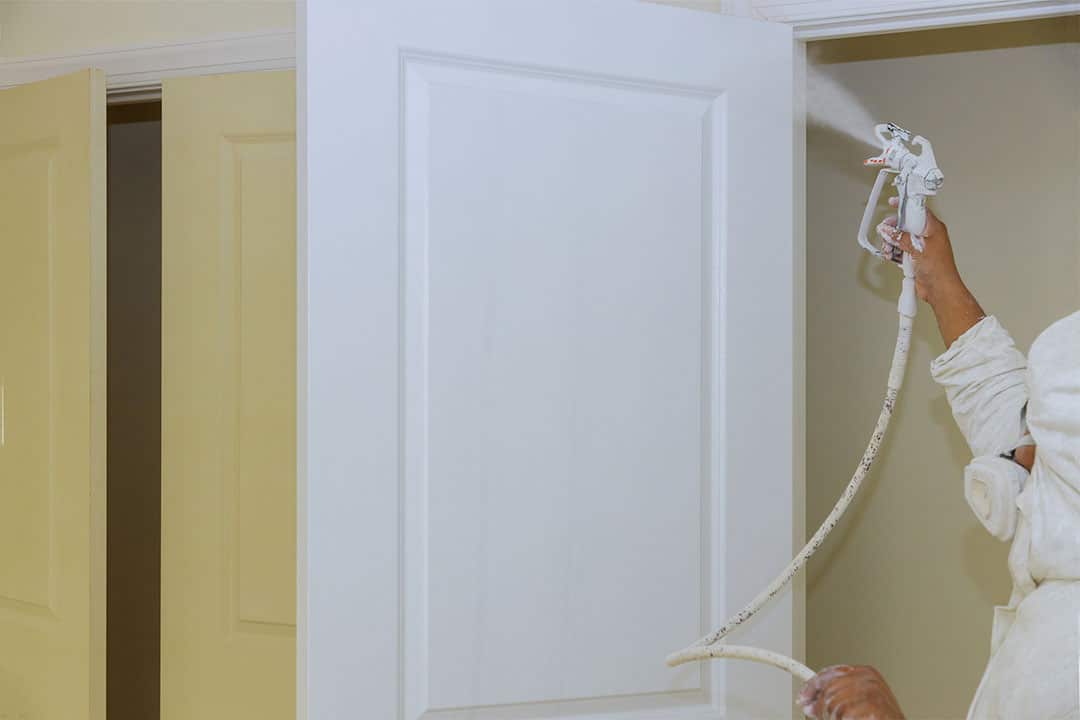
What You Will Need to Follow This Tutorial
To save time, headaches, and unintentional downtime in your power-spraying — check you have all the below items before commencing your project.
- Paint gun suitable for internal painting — such as the Wagner FLEXiO 2000.
- Step ladder.
- Drop cloths and masking tape.
- Stirring sticks for paint.
- Sandpaper.
- Paint suitable for indoor use.
- Mixing cups.
- Paint scraper.
- Heat gun.
- Suitable tip for the paint type.
- Paintbrush.
- Cleaning sponge and soapy water.
- Polythene sheeting.
- Overalls.
- Dust mask, gloves, and safety goggles.
How to Spray Paint Inside House — Step by Step Guide
Step 1 — Preparation
- Remove as much furniture, soft furnishings, ornaments, and electronic equipment from the room as possible. If certain items are immovable, relocate to the center of the room and cover with a drop cloth.
- Protect your flooring or carpets, again with a drop cloth or poly sheeting.
- Shield woodwork edges such as door and window frames, architraves, and baseboards with masking tape.
- Open doors, windows, and grills to allow substantial ventilation.
- Put on your protective equipment, and, if required, strip the old paint from the walls. Ideally, combine a scraper with a heat gun such as the Wagner HT4500 for effortless removal. If you need any tips and advice, check out my guide on removing paint with a hot air machine.
- Use a sponge and hot soapy water to clean the surface — removing any debris, dust, and detritus.
- If there are any stubborn paint flecks or uneven plasterboard — gently sand and then wash again.
- Wait for the walls to dry.
Step 2 — Painting a House Interior
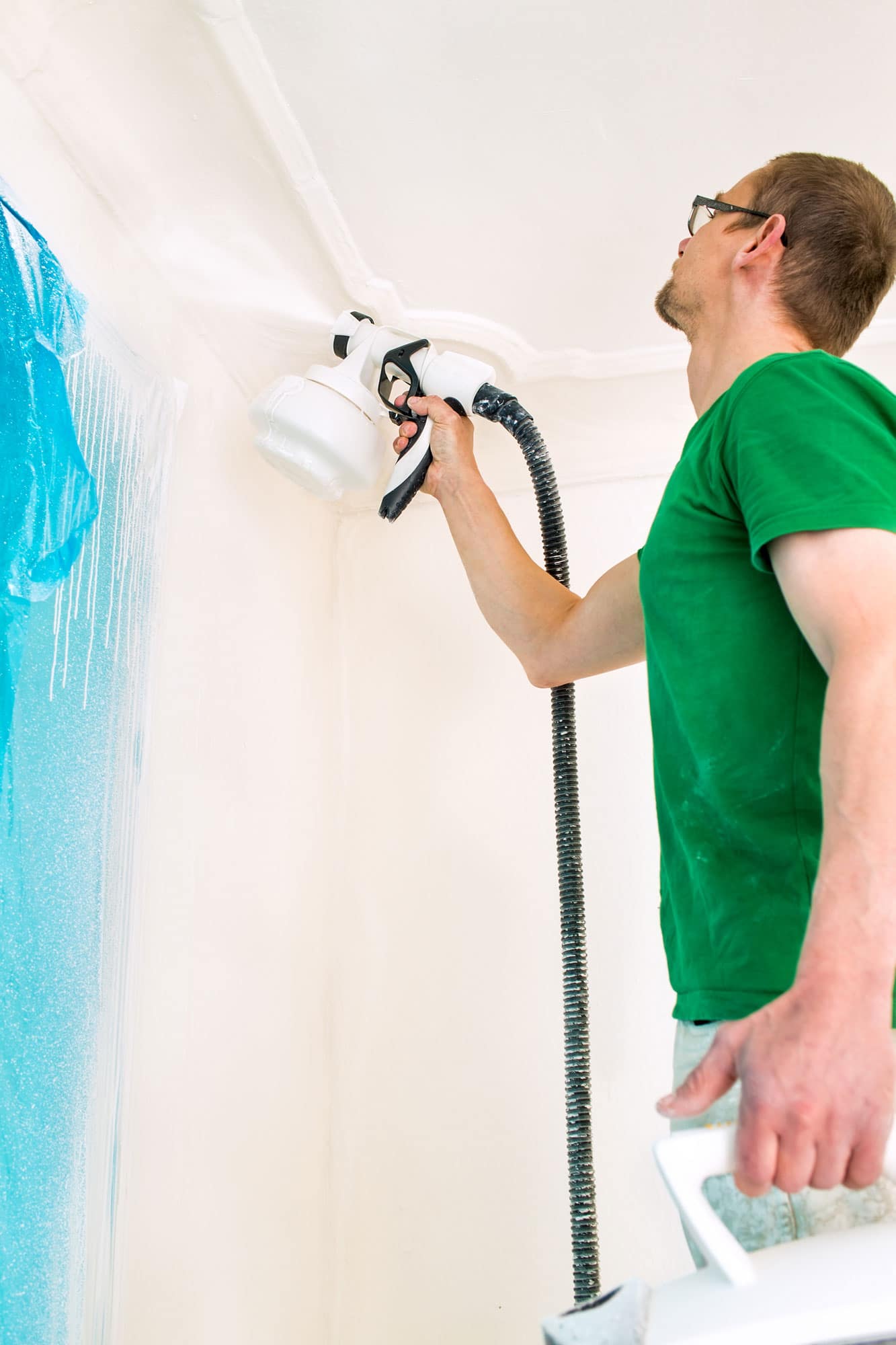
- If needed, thin your paint with thinners or water (depending on the type) and thoroughly combine in a mixing cup with a stirrer.
- Set-up your paint sprayer depending on the manufacturer’s instructions. Position the unit in a location that allows you to operate freely on the walls, with no stretching of the mains cord or hose.
- Have a test-spray on a piece of cardboard or unseen wall area to check that the paint is flowing correctly through the gun. If not, check out my guide to sprayer troubleshooting.
- Spray from top-to-bottom in a side-to-side motion, keeping the gun 8-12 inches from the wall surface. As you move along the wall, ensure you overlap the coats by 3-4 inches to prevent sparsely covered areas.
- Once completed — wait for the paint to dry and ascertain whether the walls need an additional coat.
- Address any fine-work areas with a paintbrush or fine finish nozzle.
- Light up a Cuban and admire your handiwork.
Once you’ve finished painting the exterior or interior of your home, it’s crucial to thoroughly clean your sprayer. This will both increase its longevity, and ensure that when you use it again, there’s no residual old, dried paint to ruin your fresh coat. For hints and tips — take a look at my How to Clean a Paint Sprayer article.
Our Picks of the Best Home Spray Painting Equipment Machines
Targeting the ardent DIYer, this skid-mounted hydraulic unit with a 2800 PSI motor has the grunt to address large-scale house coverage. Its 515 tip will deliver latex and chalk-based mediums effortlessly, while a pressure control knob permits you to adjust the delivery intensity to suit your paint type.
The lightweight metal gun boasts extensive knurling — providing a secure grip even with gloved, perspiring, or paint-drenched hands. Furthermore, an incorporated robust spray guard shields the tip from knocks and bumps for DIYers who take spraying to the max.
Mounted on a tubular stand, the crucial power unit is protected from any ground-dwelling moisture and dust — while also meaning you don’t have to crouch on the floor to adjust the sprayer’s controls. Furthermore, its 25-foot hose should allow you to paint an entire room without moving the unit — unless you live in a behemoth-sized property.
- Beefy 0.5 horsepower motor.
- 25-foot non-kinking hose.
- 2800 PSI power delivery.
- Integrated handle increases portability.
- Excellent online best home paint sprayer reviews.
- Reversible spray tip.
- Lacks the throughput for pro use.
- Bulky aesthetic.
- The suction tube can jump from the paint container if not secured.
- Design
- Functionality
- Price
Targeting the ardent DIYer, this skid-mounted hydraulic unit with a 2800 PSI motor has the grunt to address large-scale house coverage. Its 515 tip will deliver latex and chalk-based mediums effortlessly, while a pressure control knob permits you to adjust the delivery intensity to suit your paint type.
The lightweight metal gun boasts extensive knurling — providing a secure grip even with gloved, perspiring, or paint-drenched hands. Furthermore, an incorporated robust spray guard shields the tip from knocks and bumps for DIYers who take spraying to the max.
The suction tube allows you to draw from an original can and incorporates a mesh guard filter — protecting the internal components and guaranteeing a blemish-free finish to walls.
Mounted on a tubular stand, the crucial power unit is protected from any ground-dwelling moisture and dust — while also meaning you don’t have to crouch on the floor to adjust the sprayer’s controls. Furthermore, its 25-foot hose should allow you to paint an entire room without moving the unit — unless you live in a behemoth-sized property.
- Beefy 0.5 horsepower motor.
- 25-foot non-kinking hose.
- 2800 PSI power delivery.
- Integrated handle increases portability.
- Excellent online best home paint sprayer reviews.
- Reversible spray tip.
- Lacks the throughput for pro use.
- Bulky aesthetic.
- The suction tube can jump from the paint container if not secured.
- Design
- Functionality
- Price
A complete house spray painting equipment unit that’s rated for both indoor and outdoor use — meaning it’s as capable of addressing your living room as it is your external walls.
The flagship sprayer in the Wagner FLEXiO range — this affordable turbine machine effortlessly tackles larger-scale jobs in a time-efficient manner while staving off hand fatigue.
It boasts two cups and nozzles — a 1.5-quart container with iSpray head for substantial walls that require thick latex paints,
A proprietary X-boost turbine permits you to crank up the air delivery pressure to deal with the most viscous of paints and provide speedy coverage.
Since the HVLP turbine is located in an external floor-standing case — the overall heft of the gun is reduced — easing stress on the arms and hands. Additionally, this robust housing doubles-up as a carry and storage box — allowing for reassuring protection of the gun, nozzles, hose, and cord.
A trademarked Lock-N-Go system delivers rapid dismantling for fuss-free cleaning, while its 11.5-foot non-kinking hose should provide sufficient operational freedom to negate the requirement of an extension cord on indoor house painting projects.
- Ground-standing turbine — reducing handheld weight.
- Three spray patterns.
- Adjustable spray widths.
- Consistently one of the best home paint sprayers 2017 – 2021.
- Ideal for use with unthinned paints.
- Loud operation on the high-turbine setting.
- Cannot cope with elasticized textured paints.
- Design
- Functionality
- Price
The flagship sprayer in the Wagner FLEXiO range — this affordable turbine machine effortlessly tackles larger-scale jobs in a time-efficient manner while staving off hand fatigue.
It boasts two cups and nozzles — a 1.5-quart container with iSpray head for substantial walls that require thick latex paints, and a more modest 0.85-quart cup with a Detail Finish head for molding and trim work.
A proprietary X-boost turbine permits you to crank up the air delivery pressure to deal with the most viscous of paints and provide speedy coverage.
Since the HVLP turbine is located in an external floor-standing case — the overall heft of the gun is reduced — easing stress on the arms and hands. Additionally, this robust housing doubles-up as a carry and storage box — allowing for reassuring protection of the gun, nozzles, hose, and cord.
A trademarked Lock-N-Go system delivers rapid dismantling for fuss-free cleaning, while its 11.5-foot non-kinking hose should provide sufficient operational freedom to negate the requirement of an extension cord on indoor house painting projects.
- Ground-standing turbine — reducing handheld weight.
- Three spray patterns.
- Adjustable spray widths.
- Consistently one of the best home paint sprayers 2017 – 2021.
- Ideal for use with unthinned paints.
- Loud operation on the high-turbine setting.
- Cannot cope with elasticized textured paints.
- Design
- Functionality
- Price
Its brawny 1.55 horsepower Dura-life motor cranks out an impressive 3300 PSI — not just providing rapid coverage but also allowing it to deliver latexes, epoxies, and milks.
Furthermore, the industry-respected RX-Pro gun with 517 tip promises ultra-fine atomization for the smoothest of finishes.
Newbies to the airless spraying arena could welcome the SureFlo pusher valve — making priming effortless and preventing having to dismantle the unit should the ball valve become stuck.
Focusing on extreme property-development use and the demands of the pro-user — this sprayer features an auto-oiler function, dispensing lubrication with a simple press of a button. Furthermore, proprietary Quad+ packings prevent piston erosion by abrasive paints — and a cart-mounted design allows for straightforward transportation around the home.
- Solid trade-grade house paint sprayer reviews.
- Compact yet durable and robust.
- LCD DigiTrac display.
- Locking clip on the direct-draw suction hose.
- 50-foot hose.
- Adjustable pressure up to 3300 PSI.
- Could be overkill for the casual or intermittent DIYer.
- Design
- Functionality
- Price
Its brawny 1.55 horsepower Dura-life motor cranks out an impressive 3300 PSI — not just providing rapid coverage but also allowing it to deliver latexes, epoxies, and milks.
Furthermore, the industry-respected RX-Pro gun with 517 tip promises ultra-fine atomization for the smoothest of finishes.
The gun boasts an LCD Digi-Trac display — delivering substantial information feedback on output power, gallon throughflow, and operational time. From this screen, you can tailor the gun’s output to suit your medium and base material demands — and you can lock it with a PIN code to stop annoying colleagues from fiddling with your tool.
Newbies to the airless spraying arena could welcome the SureFlo pusher valve — making priming effortless and preventing having to dismantle the unit should the ball valve become stuck.
Focusing on extreme property-development use and the demands of the pro-user — this sprayer features an auto-oiler function, dispensing lubrication with a simple press of a button. Furthermore, proprietary Quad+ packings prevent piston erosion by abrasive paints — and a cart-mounted design allows for straightforward transportation around the home.
- Solid trade-grade house paint sprayer reviews.
- Compact yet durable and robust.
- LCD DigiTrac display.
- Locking clip on the direct-draw suction hose.
- 50-foot hose.
- Adjustable pressure up to 3300 PSI.
- Could be overkill for the casual or intermittent DIYer.
- Design
- Functionality
- Price
The machine arrives with Graco’s contractor-grade SG2 gun. Featuring a RAC IV 515 tip, this unit effortlessly knocks out latex and chalks through its 25-foot Duraflex hose. And, with the heart of the sprayer boasting a 0.5 horsepower motor with 3000 PSI of output — it delivers a rapid 0.27 gallons per minute, meaning speedy completion of large house painting jobs.
A lightweight skid-stand elevates the unit from the floor, protecting the vital components from moisture and dirt ingress. Additionally, novice users may appreciate that not only is the unit effortless to operate, but it also arrives complete with an instructional guide and DVD — and boasts a PowerFlush adaptor for stress-free post-project cleaning.
- 25-foot hose — can handle up to 75 feet.
- Stainless steel piston for longevity.
- Reversible tip with spray guard.
- Suitable for use with unthinned paints.
- Lightweight for a ground-standing turbine.
- Some of the best online airless residential paint sprayer reviews.
- Excessive vibration on high pressure — making the unit ‘walk.’
- Tradespeople may find 125 gallons per annum is insufficient.
- Design
- Functionality
- Price
The machine arrives with Graco’s contractor-grade SG2 gun. Featuring a RAC IV 515 tip, this unit effortlessly knocks out latex and chalks through its 25-foot Duraflex hose. And, with the heart of the sprayer boasting a 0.5 horsepower motor with 3000 PSI of output — it delivers a rapid 0.27 gallons per minute, meaning speedy completion of large house painting jobs.
The suction tube and filter are compatible with one and five-gallon original paint containers, negating the requirement for frequent refilling. Furthermore, rated for an annual usage of 125 gallons — it’s sufficiently robust and durable to cope with hardcore DIY use.
A lightweight skid-stand elevates the unit from the floor, protecting the vital components from moisture and dirt ingress. Additionally, novice users may appreciate that not only is the unit effortless to operate, but it also arrives complete with an instructional guide and DVD — and boasts a PowerFlush adaptor for stress-free post-project cleaning.
- 25-foot hose — can handle up to 75 feet.
- Stainless steel piston for longevity.
- Reversible tip with spray guard.
- Suitable for use with unthinned paints.
- Lightweight for a ground-standing turbine.
- Some of the best online airless residential paint sprayer reviews.
- Excessive vibration on high pressure — making the unit ‘walk.’
- Tradespeople may find 125 gallons per annum is insufficient.
- Design
- Functionality
- Price
The key to this unit is user-tailorability — allowing you to adjust the delivery to suit the density of your paint medium and base material demands.
Offering delivery up to eight times faster than a standard handheld brush, the unit should make light work of room applications. And, with a generous 1.5-quart gun-mounted cup, it should have sufficient capacity to cover 120 square feet of walling without having to replenish the container.
The unit arrives with Wagner’s versatile iSpray nozzle — a gun tip that can deliver thick latex paints with no thinning. A six-foot cord allows for significant operational freedom, although for larger rooms, an extension cable may be necessary.
A mean black design gives the unit an impressive aesthetic — which may appeal to DIY users who want a hardcore-looking machine. Furthermore, as with all Wagner’s handheld sprayers, this machine boasts trademarked Lock-N-Go tech — permitting you to effortlessly break down the unit into five components for headache-free cleaning post-job.
- Excellent DIY paint sprayers house interior machine.
- X-Boost power control.
- Low bounceback iSpray nozzle.
- Large paint container.
- Choice of three spray settings.
- No additional detail nozzles.
- Struggles with heavily-textured paint.
- Design
- Functionality
- Price
The key to this unit is user-tailorability — allowing you to adjust the delivery to suit the density of your paint medium and base material demands. This is facilitated through a powerful twin-speed X-boost turbine, three spray fan patterns, and a 12-stage airflow gauge.
Offering delivery up to eight times faster than a standard handheld brush, the unit should make light work of room applications. And, with a generous 1.5-quart gun-mounted cup, it should have sufficient capacity to cover 120 square feet of walling without having to replenish the container.
The unit arrives with Wagner’s versatile iSpray nozzle — a gun tip that can deliver thick latex paints with no thinning. A six-foot cord allows for significant operational freedom, although for larger rooms, an extension cable may be necessary.
A mean black design gives the unit an impressive aesthetic — which may appeal to DIY users who want a hardcore-looking machine. Furthermore, as with all Wagner’s handheld sprayers, this machine boasts trademarked Lock-N-Go tech — permitting you to effortlessly break down the unit into five components for headache-free cleaning post-job.
- Excellent DIY paint sprayers house interior machine.
- X-Boost power control.
- Low bounceback iSpray nozzle.
- Large paint container.
- Choice of three spray settings.
- No additional detail nozzles.
- Struggles with heavily-textured paint.
- Design
- Functionality
- Price
This HVLP turbine sprayer features Wagner’s upgraded low-overspray iSpray nozzle — ideal for addressing large expanses such as ceilings and walls. Combined with its acrylic 1.5-quart cup container— you can cover up to 120 square feet without replenishing.
This machine enjoys extensive tailorability — with user-adjustable turbine power, fan spray patterns, and material flow. Additionally, a 15-foot non-kinking hose should allow you to paint an entire room without moving the base unit.
A substantial ergonomic gun handle with a rubberized grip promotes reassuring stability — while having the turbine located in an external casing ensures the shooter remains lightweight, boosting stamina.
- Multi-paint compatible.
- X-Boost for adjustable turbine pressure.
- Carrying handle for effortless portability.
- Customizable spray width.
- Ideal entry-level stationary sprayer.
- Noisy operation.
- Design
- Functionality
- Price
This HVLP turbine sprayer features Wagner’s upgraded low-overspray iSpray nozzle — ideal for addressing large expanses such as ceilings and walls. Combined with its acrylic 1.5-quart cup container— you can cover up to 120 square feet without replenishing.
For work that necessitates a more precise approach, you can switch to the Detail Finish head. Featuring a modest 0.85-quart container, it permits you to access more restricted areas and corners than a larger container would allow.
This machine enjoys extensive tailorability — with user-adjustable turbine power, fan spray patterns, and material flow. Additionally, a 15-foot non-kinking hose should allow you to paint an entire room without moving the base unit.
A substantial ergonomic gun handle with a rubberized grip promotes reassuring stability — while having the turbine located in an external casing ensures the shooter remains lightweight, boosting stamina.
- Multi-paint compatible.
- X-Boost for adjustable turbine pressure.
- Carrying handle for effortless portability
- Customizable spray width.
- Ideal entry-level stationary sprayer.
- Noisy operation.
- Design
- Functionality
- Price
Featuring HEA (high-efficiency airless) tech, this machine reduces overspray by 55 percent — meaning more paint hits the target and isn’t lost to air atomization — saving you dollars and keeping the amount of mess down.
As a prosumer DIY unit — durability is at the heart of the machine. It boasts a hydraulic pump that the manufacturer states will outlast its competitors by up to three times. Furthermore, the entire fluid section is removable — allowing you to thoroughly rinse the components post-project to increase longevity.
This sprayer features a 25-foot hose and has five adjustable pressure settings. Additionally, you can alter both material volume delivery, spray width, and the fan pattern shape.
- Affordable prosumer sprayer with professional results.
- Lightweight and durable detachable gun.
- Reduces overspray by 55 percent.
- Ideal for rapid coverage projects.
- Fuss-free maintenance.
- Post-project cleaning can be time-consuming.
- Challenging to assemble for first-time users.
- Design
- Functionality
- Price
Featuring HEA (high-efficiency airless) tech, this machine reduces overspray by 55 percent — meaning more paint hits the target and isn’t lost to air atomization — saving you dollars and keeping the amount of mess down.
Its 0.55 horsepower motor effortlessly drives heavily viscous paints such as primers, oils, latexes, and 2-in-1s through its versatile 515 nozzle tip. And, drawing paint into the gun directly from an original can, there’s no requirement to refill the sprayer.
As a prosumer DIY unit — durability is at the heart of the machine. It boasts a hydraulic pump that the manufacturer states will outlast its competitors by up to three times. Furthermore, the entire fluid section is removable — allowing you to thoroughly rinse the components post-project to increase longevity.
This sprayer features a 25-foot hose and has five adjustable pressure settings. Additionally, you can alter both material volume delivery, spray width, and the fan pattern shape.
- Affordable prosumer sprayer with professional results.
- Lightweight and durable detachable gun.
- Reduces overspray by 55 percent.
- Ideal for rapid coverage projects.
- Fuss-free maintenance.
- Post-project cleaning can be time-consuming.
- Challenging to assemble for first-time users.
- Design
- Functionality
- Price
Built for extreme and intense use, the sprayer boasts a durable floor-standing metal casing — able to withstand the bumps and knocks concomitant to house improvement. Inside the housing is a mighty two-stage turbine — cranking out 5 PSI that allows rapid coverage of walls, doors, and ceilings. Furthermore, this high power output enables fuss-free propulsion of enamels, milks, latexes, and chalks.
Rear-mounted gun dials permit easy access during operation — allowing you to fine-tune volume flow and airflow with just your fingertips. And, with a 25-foot Hi-Flex hose, the sprayer enables freedom of operation with no fear of annoying kinks.
In addition to the gun, hose, and turbine unit — this machine arrives complete with a wrench, cleaning brush, and viscosity cup.
- Built and designed in Canada.
- Fuss-free quick connect air control valve and coupling.
- Two-year warranty on parts and labor.
- Low bounce-back and overspray.
- Designed to endure hardcore work in the field.
- Could be overkill for casual DIYers.
- No detail nozzle — needs to be purchased separately.
- Design
- Functionality
- Price
Built for extreme and intense use, the sprayer boasts a durable floor-standing metal casing — able to withstand the bumps and knocks concomitant to house improvement. Inside the housing is a mighty two-stage turbine — cranking out 5 PSI that allows rapid coverage of walls, doors, and ceilings. Furthermore, this high power output enables fuss-free propulsion of enamels, milks, latexes, and chalks.
Paint delivery is via the respected M-Model metal non-bleed gun. Featuring a fine-atomizing HVLP 1.3 mm air cap, it promises a showroom-like finish. Additionally, its bottom-feeding one-quart siphon cup has sufficient capacity for the majority of house projects.
Rear-mounted gun dials permit easy access during operation — allowing you to fine-tune volume flow and airflow with just your fingertips. And, with a 25-foot Hi-Flex hose, the sprayer enables freedom of operation with no fear of annoying kinks.
In addition to the gun, hose, and turbine unit — this machine arrives complete with a wrench, cleaning brush, and viscosity cup.
- Built and designed in Canada.
- Fuss-free quick connect air control valve and coupling.
- Two-year warranty on parts and labor.
- Low bounce-back and overspray.
- Designed to endure hardcore work in the field.
- Could be overkill for casual DIYers.
- No detail nozzle — needs to be purchased separately.
- Design
- Functionality
- Price
Delivering a pleasing 55 percent less overspray than its similarly-rated competitors, this machine provides a rewarding coat with the minimum of wastage, bounceback, dripping, and mess.
A robust tubular frame stand boosts portability and protects the hydraulic pump from ground-dwelling water and detritus. Furthermore, the suction hose not only negates the requirement for refilling — it also boasts a fine-mesh filter to protect the internal components and ensure a blemish-free coat.
This airless unit provides versatility with its adjustable pressure settings, variable material control, and a locking trigger — keeping finger fatigue to a minimum.
- Delivers 3000 PSI at 0.28 gallons per minute.
- Affordable entry-level airless home sprayer.
- Adjustable pressure output control.
- 25-foot hose.
- Choice of two spray tips.
- Obtaining replacement parts is challenging.
- Stand lacks a carrying handle.
- Design
- Functionality
- Price
Delivering a pleasing 55 percent less overspray than its similarly-rated competitors, this machine provides a rewarding coat with the minimum of wastage, bounceback, dripping, and mess.
The sprayer gun arrives with two nozzle tips — sizes 513 and 517. This increases the flexibility of the unit, allowing it to propel both thin and dense mediums for fine detail work and large coverage respectively. Additionally, the handle of the shooter is knurled and rubberized — elevating hand traction, ensuring stability, and promoting a relaxed grip.
A robust tubular frame stand boosts portability and protects the hydraulic pump from ground-dwelling water and detritus. Furthermore, the suction hose not only negates the requirement for refilling — it also boasts a fine-mesh filter to protect the internal components and ensure a blemish-free coat.
This airless unit provides versatility with its adjustable pressure settings, variable material control, and a locking trigger — keeping finger fatigue to a minimum.
- Delivers 3000 PSI at 0.28 gallons per minute.
- Affordable entry-level airless home sprayer.
- Adjustable pressure output control.
- 25-foot hose.
- Choice of two spray tips.
- Obtaining replacement parts is challenging.
- Stand lacks a carrying handle.
- Design
- Functionality
- Price
At its core is a powerful 200 cc gasoline-powered Honda engine, knocking out 3300 PSI. It enables this mother-of-all-sprayers to propel seriously dense liquids — including epoxies, elastomerics, block wall fillers, fire retardants, roof coatings, and textured paints.
Naturally, when working inside a property, you probably don’t want the noise and fumes associated with a gas-driven motor.
The machine arrives with a Graco Texture gun — offering four-finger operation, it ensures fatigue is reduced, allowing you to effortlessly tackle substantial projects. Furthermore, this shooter boasts two interchangeable reversible spray tips — sizes 427 and 531.
The hydraulic powerhouse is mounted on a low-level cart. With pneumatic tires, it means straightforward portability even on rough terrain — crucial if you’re utilizing the machine on a new-build property construction site.
A massive 100-foot hose means you’re not constantly relocating the base unit and ensures easy access to high-level areas, including roofing. Thankfully, with a proprietary QuikReel hose management system, this monster of a hose is protected against kinks, twists, and coils — and allows you to easily retrieve and store and the end of your working day.
- An extensive cooling system promotes longevity and prevents breakdowns.
- ProConnect pump ensures rapid pump removal — reducing downtime.
- Quick-replace filters.
- Choice of either electric or gasoline drive.
- Propels the densest of paints and coatings.
- Not suited to fine-finish home painting work.
- Premium price for a premium product.
- Design
- Functionality
- Price
At its core is a powerful 200 cc gasoline-powered Honda engine, knocking out 3300 PSI. It enables this mother-of-all-sprayers to propel seriously dense liquids — including epoxies, elastomerics, block wall fillers, fire retardants, roof coatings, and textured paints.
Naturally, when working inside a property, you probably don’t want the noise and fumes associated with a gas-driven motor. Thankfully, this unit has the versatility to switch to electric power for those internal jobs.
The machine arrives with a Graco Texture gun — offering four-finger operation, it ensures fatigue is reduced, allowing you to effortlessly tackle substantial projects. Furthermore, this shooter boasts two interchangeable reversible spray tips — sizes 427 and 531.
The hydraulic powerhouse is mounted on a low-level cart. With pneumatic tires, it means straightforward portability even on rough terrain — crucial if you’re utilizing the machine on a new-build property construction site.
A massive 100-foot hose means you’re not constantly relocating the base unit and ensures easy access to high-level areas, including roofing. Thankfully, with a proprietary QuikReel hose management system, this monster of a hose is protected against kinks, twists, and coils — and allows you to easily retrieve and store and the end of your working day.
- An extensive cooling system promotes longevity and prevents breakdowns.
- ProConnect pump ensures rapid pump removal — reducing downtime.
- Quick-replace filters.
- Choice of either electric or gasoline drive.
- Propels the densest of paints and coatings.
- Not suited to fine-finish home painting work.
- Premium price for a premium product.
- Design
- Functionality
- Price
Conclusion
Faster than a brush and a roller, more enjoyable to wield, easier on the arms, and providing a more even coat — they’re a no-brainer for home wall coverage.
When selecting your ideal machine — first and foremost, decide whether to opt for an HVLP turbine or an airless hydraulic unit. HVLPs are more straightforward to operate, lighter on the wallet, and provide a finer finish than airless examples. Conversely, hydraulic units allow for a faster speed of coverage and can deliver thicker paints than their turbine cousins.
Additionally, ensure that the gun tip is compatible with the mediums you’re planning on using and that the hose is sufficiently lengthy to reach the corners of your room or the top of your house. Furthermore, consider whether a turbine paint cup will have sufficient capacity for your projects — or whether you need the direct-draw feature of an airless sprayer.
Sure, you can be a traditionalist and extend unnecessary effort and time with a handheld brush — but if you want to join the pro-ranks of house coverage, you need a house paint sprayer.
Paint Spray Gun for Home Use FAQs
Q: What Is the Best Airless Paint Sprayer for Home Use?
In my opinion, the best spray paint machine for home exteriors is the latex-compatible, airless HomeRight 2800. For interior work, I suggest checking out the handheld and low overspray Wagner 2000.
Q: What Is the Best Paint Sprayer for Home Use With A Hydraulic Pump?
Boasting a 0.5 horsepower motor that delivers 3000 PSI, one of the best airless sprayers is the prosumer level Graco Magnum X5. Having multi-medium compatibility and the ability to rapidly cover expansive areas — it’s an excellent home wall paint sprayer.
Q: How Can I Make a Homemade Paint Sprayer?
Advancements in technology have made electric paint sprayers highly affordable. Even high-end DIY units such as the HVLP Wagner 2000 and the airless Himalaya are within reach of most pockets — meaning you don’t need to make your own machine.
However, if you really want to be creative and make your own sprayer, I’ve included a How-To video below. Bear in mind, it will make a lot of mess, provide uneven coverage, and be seriously wasteful on paint.

Q: Can I Spray Paint Inside My House?
Yes. There are many excellent interior home sprayers, such as the FLEXiO 5000, Wagner 2000, and the Fuji 2202. When painting indoors, always ensure that there is adequate ventilation, you wear a respirator mask, and you protect furniture and furnishings with a drop cloth.
Q: Does Spraying Use More Paint Than Rolling?
Yes. On average, a power paint sprayer uses around 20-30 percent more paint than a roller. However, they provide more rapid coverage than a handheld tool and ensure a smoother final coat.
That said, there are excellent high-efficiency airless machines such as the Wagner 150 that use a little more paint than a traditional roller.
Q: How to Spray Paint a House Interior?
Painting a house interior with a paint machine is straightforward. Preparation is key. Ensure that you thoroughly clean, wash, scrape, or sand your target area before commencing work — and that you wear the relevant protective equipment.
Check out my comprehensive 101 guide to spray painting inside your home.

